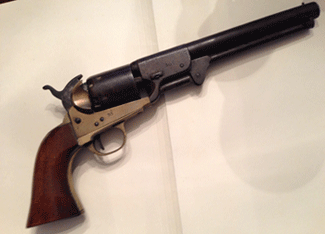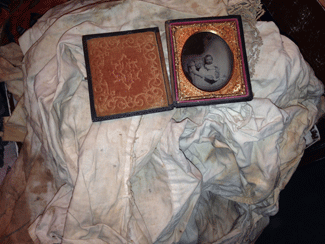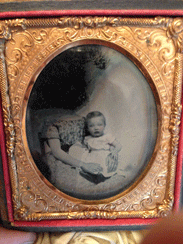|
Mr. Sexton, 40 years ago, my husband Jack and I bought a house built in the mid-1800s by a whaling ship's captain on the east end of Long Island. Not much had been changed in the house, and there was never any insulation in it. While we were preparing to have insulation blown into the floor of the attic, we removed several floorboards, and the pistol was found stuffed under the beams. It was wrapped in old cotton undergarments of the type worn in that time and with it was a leather-bound picture printed on glass (also dating to around the 1850s). The picture was of a young woman with a baby on her lap. For this reason, I believe the pistol must be authentic. Another reason I believe it is authentic is because we found out from our local historian that our house was built by the captain to house his crew members. This led me to imagine all kinds of reasons for the pistol being left as it was—perhaps he never returned from a tour at sea to retrieve it? I appreciate anything you may be able to tell me.
|

|
Confederate Griswold revolver found in a house belonging to a whaling ship captain on Long Island, N.Y., $20,000-$30,000.
|
JS: What a wonderful discovery. I've heard of many objects found in walls, but yours is the first Confederate handgun. The cotton shirts the gun was wrapped in also appear to be of the Civil War Era, and the ambrotype of the mother and child dates from the 1860s, too. If only it could talk. Maybe a sailor living in the house after the war was the ex-Confederate who owned the pistol, and the image wrapped in the shirts was of his wife and baby.
Regardless of who carried the revolver, it is quite a rare gun made by the largest manufacturer of Confederate handguns in the South. Before the war, Samuel Griswold manufactured cotton gins near Macon, Georgia. He was a transplanted Connecticut Yankee who had great business and manufacturing means in the community known as Griswoldville. Griswold was postmaster and the largest employer.
|

|

|
The Griswold revolver was found wrapped in 1800’s cotton undershirts and was with a photo of a woman and child.
|
Near the war's beginning, Griswold made polearms for the State of Georgia and started the manufacture of revolvers based on Samuel Colt's popular model 1851 Navy revolver. Colt-style revolvers utilizing his "patented ratcheted, rotating and locking cylinder" could only be made legally with Colt's approval and with payment of royalties, which was not necessary in the Confederate States which did not recognize Union law.
Function and design closely emulate the Colt, though the frame is brass and the barrel round, more like that of Colt Dragoon revolvers. Brass was utilized in frames due to the lack of steel and the ease among the skilled slaves and free workmen for working this metal. Lack of steel also caused an innovation in iron being twisted when red hot to give it strength and temper. The twist lines are easily seen in the cylinder of your gun.
Though Griswold revolvers are the most common of all CS revolvers, there are different models, and yours is an example of the earliest and scarcest. These early guns are all numbered under serial number 100. The few examples that are known to me are serial numbers 8, 29, 31, 64 and 90.
These early first models have smaller trigger guards than other models. This is really the only visible difference that is easily seen externally; however, under close scrutiny, there are other differences internally that were changed to strengthen later standard production pistols. These were subtle changes in adding cast pins to attach the barrel housing to the frame instead of using separate iron pins, which are missing on this gun and often on other pre-100 serial number guns.
The cylinder arbors also have a stronger form of attachment in standard production models; one large wedge replaced two iron pins like on yours, serial number 30. These design changes were necessitated after the first guns exhibited frame weakness and proved to be unserviceable after some use.
There is a crack on the left side of the frame on both SN 8 and 30 pistols, showing this inherent design problem on these rare, early guns. I imagine the same defect might be seen on the other examples of these "first model-first types.”
It has always been known among Confederate handguns researchers and authors that it was quite possible that the earliest Griswold revolvers were possibly the product of A. W. Gunnison in New Orleans and not Samuel Griswold. Wiley Sword in his excellent text Firepower from Abroad published by Mobray in 1986 states on pages 109-110: "While considerable information has been published about Samuel Griswold of Griswoldville, Georgia, there has been a corresponding lack of data about his partner, A. W. Gunnison. As it now appears, Gunnison was involved in manufacturing the Colt-type Navy revolver in New Orleans prior to the city's capture in late April 1862. Since a portion of his machinery was moved to Griswoldville, this undoubtedly was the basis for the conversion of the cotton gin/pike manufacturing facility of Griswold’s into a revolver factory."
A letter from A. W. Gunnison to the Confederate Secretary of War written from Macon, Georgia, May 14, 1862, also printed in Sword’s book, stated: "I was involved in the manufacture of Colt's Navy revolver in New Orleans at the time of capture by the enemy, from which place I have escaped with portions of my machinery to reestablish the same work at Griswoldville...."
William Gary in the best overall text, Confederate Revolvers, shows two revolvers serial numbered 16 and 45 he believed to be made by Gunnison in New Orleans. I know of at least two other guns of the same configuration with different serial numbers (5 and 55), but always the same die styles. In my opinion, these somewhat standard-looking Griswolds with second model features of half-octagonal barrel housing and typical large trigger guards associated with standard production guns are suspect as to actually being Civil War-produced guns—that is my opinion exclusively. Gary notes in his book on page 11, "While he (Gunnison) undoubtedly got most of his machinery out, he did not get his serial number dies and had to make new ones before starting production at Griswoldville."
Serial numbers noted on known first model-first types 8, 30, 64 and 90 mentioned earlier appear to have utilized the same dies that occur on other standard production Griswolds (for serial numbers and cryptics), making previously published "Gunnison revolvers" unlikely in my opinion and making a strong case that the serial number 30 revolver here was indeed made in New Orleans early in 1862.
Your gun should be restored by a competent gunsmith and should sell for at least what other nice standard production examples sell for. There are many comparable auction sales for Griswold revolvers in the $20,000 range in last few years, and regardless of their history or rare pattern, condition seems to rule the antique gun market. Auction records show serial number 8 sold at James Julia Auctions October 2009 for $30,050 and for $20,315 at Heritage Auctions in Dallas, Texas, on December 10, 2010. I value your gun in same range of $20,000-$30,000.
This wonderful relic of the Confederacy would make a great conversation piece for your bed-and-breakfast Willow Hill House in the wine country of Long Island. I imagine there would be more than one Civil War aficionado who would visit your B&B just to view the gun, what a wonderful find.
|